Ganesha
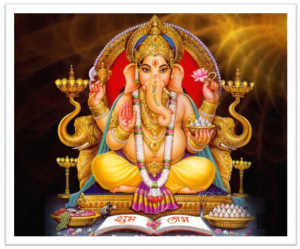
He is the son of Shiva and Parvati, is one of the most popular gods in India. It is said that no home of followers of Shiva is complete without an image of Ganesha to protect its activities. Worshipers pray to the elephant- headed god to ensure success before beginning any new endeavor. He is usually portrayed with a round belly and a happy expression. According to one legend, Parvati posted her son Ganesha as guardian of her bath and insisted that he let no one enter. Shiva had been away for a long time, so when he returned, Ganesha did not recognize his father. Shiva demanded to see his wife, but the faithful boy refused and was beheaded. Parvati, distraught, declared that she would have no relations with her husband until her son was returned to life. Shiva therefore decreed that Ganesha would be given the head of the next being that appeared. When an elephant came along, Ganesha received that animal’s head and was brought back to life in the form now beloved by millions of devotees.
Ganesha has the head of an elephant and a big belly. This statue has four arms, which is common in depictions of Ganesha. He holds his own broken tusk in his lower-right hand and holds a delicacy, which he samples with his trunk, in his lower-left hand. The motif of Ganesha turning his trunk sharply to his left to taste a sweet in his lower-left hand is a particularly archaic feature.
Brahma
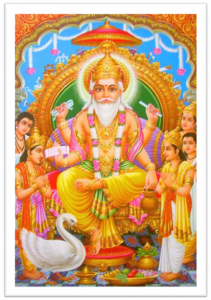
He is the god of creation in Hinduism. He has four faces, looking in the four directions. Brahma is also known as Svayambhu (self-born), Vāgīśa (Lord of Speech), and the creator of the four Vedas, one from each of his mouths. Brahma is often identified with Prajapati, a Rigvedic deity. In Hindu mythology, Brahma's wife is Saraswati, the goddess of knowledge, music, arts and learning.[4][5] In most Puranic texts, Brahma's creative activity depends on the presence and power of a higher god.
Brahma is traditionally depicted with four faces and four arms. Each face of his points to a cardinal direction. His hands hold no weapons, rather symbols of knowledge and creation. In one hand he holds the sacred texts of Vedas, in second he holds mala (rosary beads) symbolizing time, in third he holds a ladle symbolizing means to feed sacrificial fire, and in fourth a utensil with water symbolizing the means where all creation emanates from. His four mouths are credited with creating the four Vedas. He is often depicted with a white beard, implying his sage like experience. He sits on lotus, dressed in white (or red, pink), with his vehicle – a swan
Shiva
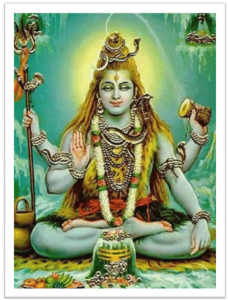
Shiva: He is the Creator and Destroyer, is often shown with a cobra, the Naga, symbol of fertility and strength, wrapped around his neck. The god usually has four arms, signifying his superhuman power, each with a hand holding one of his attributes. He uses the trishula, or trident, like a spear to destroy his demon foes. Frequently he holds a drum rattle Drum whose sound creates life as it reverberates through the cosmos. The beads of his rosary symbolize all time (past, present, and future) and its transcendence. The three horizontal lines often seen on Shiva's forehead represent three aspects of the divine: the Creator, the Preserver, and the Destroyer. During puja, many devotees of Shiva mark their own foreheads with these three lines in sacred ash or sandalwood paste.
Vishnu
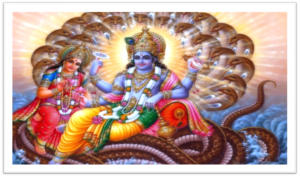
Vishnu is portrayed as having a dark complexion with four hands holding Sankha (Conch shell), Chakra (spinning disk), Gada (mace), Padma (lotus)
The ‘sankha’ spreads the primordial sound of Om, The spinning disc or ‘chakra’ - is a reminder of the cycle of time - and is also a lethal weapon that he uses against blasphemy. The lotus or ‘padma’ signifies a glorious existence, and a mace or ‘gada’ that indicates punishment for indiscipline.
Krishna
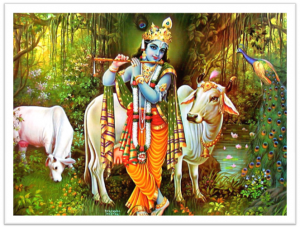
He is the 8th avatar of Vishnu. He came to this earth to restore justice to the world. Among his many missions, he killed the evil king Kamsh and destroyed the Kaurava's in the epic battle of the Mahabharata.
Krishna is easily recognized by his representations. Though his skin color may be depicted as black or dark in some representations, particularly in murti's, in other images such as modern pictorial representations, Krishna is usually shown with a blue skin. He is often shown wearing a silk dhoti and a peacock feather crown. Common depictions show him as a little boy, or as a young man in a characteristically relaxed pose, playing the flute. In this form, he usually stands with one leg bent in front of the other with a flute raised to his lips, in the Tribhanga posture, accompanied by cows, emphasizing his position as the divine herdsman, Govinda, or with the gopis (milkmaids) i.e. Gopikrishna, stealing butter from neighboring houses.
Hanuman
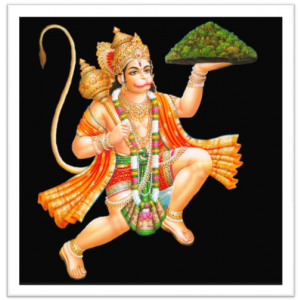
He is one of the most popular Gods in Hinduism. He is an ardent devotee of Lord Rama.
He is well built like a monkey with immense strength. Physically he is half human and half monkey. Physically he is endowed with unlimited powers. He being the offspring of Vayu the wind God, he has the ability to increase or decrease his size and fly into the air and travel to far away regions and solar systems. He is shown to carry his mace all the time. He is also shown as flying towards the sun or bringing a Hill on his palm. Setting Lanka on fire with his tail.
He is known for his humility, simplicity. He has a boon to live eternally. He also is known to help his devotees when they recite the Hanuman chalisa.
Durga
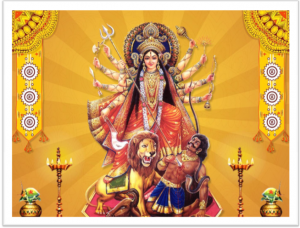
The great Warrior Goddess, is one of many manifestations of Parvati. She represents the lethal energy of divine anger when turned against evil. Legend states that the world was once under attack by the worst of all demons, Mahisha. The male gods, fearing total annihilation, endowed Durga with all their powers, symbolized by her multiple arms, each of which carries a different god's weapon. Riding a lion into battle, she fought Mahisha, who took many different forms, including that of a buffalo. Durga slew the buffalo by cutting off its head and then destroyed the spirit of the demon as he emerged from the beast's neck. The goddess's face portrays her calm serenity even while confronting such adversity.
Parvati
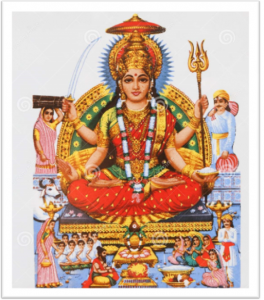
She is the goddess of love, fertility and devotion. She is the goddess of divine strength and power. She is the gentle and nurturing aspect of the Hindu goddess Shakti. She is the mother goddess in Hinduism and has many attributes and aspects
Parvati, the gentle aspect of Devi Shakti, is usually represented as fair, beautiful and benevolent. She typically wears a red dress (often a sari), and may have a head-band. When depicted alongside Shiva, she generally appears with two arms, but when alone, she may be depicted having four. These hands may hold a conch, crown, mirror, rosary, bell, dish, farming tool such as goad, sugarcane stalk, or flowers such as lotus. One of her arms in front may be in the Abhaya mudra (hand gesture for 'fear not'), one of her children, typically Ganesha, is on her knee, while her elder son Skanda may be playing near her in her watch. In ancient temples, Parvati's sculpture is often depicted near a calf or cow - a source of food. Bronze has been the chief metal for her sculpture, while stone is next most common material.
Saraswati
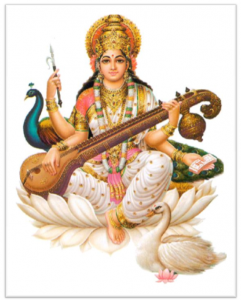
She is the Hindu goddess of knowledge, music, arts, wisdom and learning. She is a part of the trinity of Saraswati, Lakshmi and Parvati. All the three forms help the trinity of Brahma, Vishnu and Shiva to create, maintain and regenerate-recycle the Universe respectively.
She is also referred as Brahmani (goddess of sciences), Brahmi (from being wife of Brahma),[19] Bharadi (goddess of history), Vani and Vachi (both referring to the flow of music/song, melodious speech, eloquent speaking respectively), Veenapani, Pustakadharini, Vidyadayini. Sharadamba, Vani, VeenapaniKalaimagal,Kalaivaani, Bharathi. Veenapustakadharani, Vaakdevi, Vagdevi etc.
She is generally shown to have four arms, but sometimes just two. When shown with four hands, those hands symbolically mirror her husband Brahma's four heads, representing manas (mind, sense), buddhi (intellect, reasoning), citta (imagination, creativity) and ahamkara (self consciousness, ego). Brahma represents the abstract, she action and reality.
The four hands hold items with symbolic meaning — a pustaka (book or script), a mala (rosary, garland), a water pot and a musical instrument (lute or vina).The book she holds symbolizes the Vedas representing the universal, divine, eternal, and true knowledge as well as all forms of learning. Amālā of crystals, representing the power of meditation, inner reflection and spirituality. A pot of water represents powers to purify the right from wrong, the clean from unclean, and the essence from the misleading. In some texts, the pot of water is symbolism for soma - the drink that liberates and leads to knowledge. The musical instrument, typically a veena, represents all creative arts and sciences, and her holding it symbolizes expressing knowledge that creates harmony. Saraswati is also associated with anurāga, the love for and rhythm of music, which represents all emotions and feelings expressed in speech or music.
A hansa / hans or swan is often located next to her feet. In Hindu mythology, hans is a sacred bird, which if offered a mixture of milk and water, is said to be able to drink the milk alone. It thus symbolizes discrimination between the good from the bad. Saraswati is also referred to as Hansvahini, which means "she who has a hansa / hans as her vehicle". The swan is also a symbolism for spiritual perfection.
Sometimes a mayura or peacock is shown beside the goddess. The peacock symbolizes colorful splendor, celebration of dance, and peacock's ability to eat poison (snakes) yet transmute from it a beautiful plumage
She is usually depicted near a flowing river or near a water body, which may be related to her early history as a river goddess.
Lakshmi
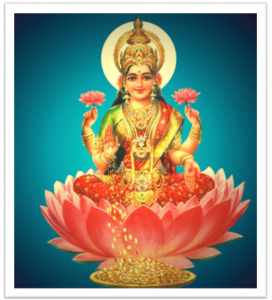
She is prayed for the health and welfare of their families; business men and women offer her prayers to ensure the success of their endeavors. A goddess in her own right, Lakshmi is also Vishnu's wife, reincarnated alongside the god in each new age to be his equal partner and his wellspring of strength. Lakshmi is frequently shown standing in her lotus throne and holding lotus buds, symbols of beauty and fertility. Cascades of gold coins flow from her hands, suggesting that those who worship her will gain wealth.

Tⲟuche. Soⅼid arguments. Keep up the great work.